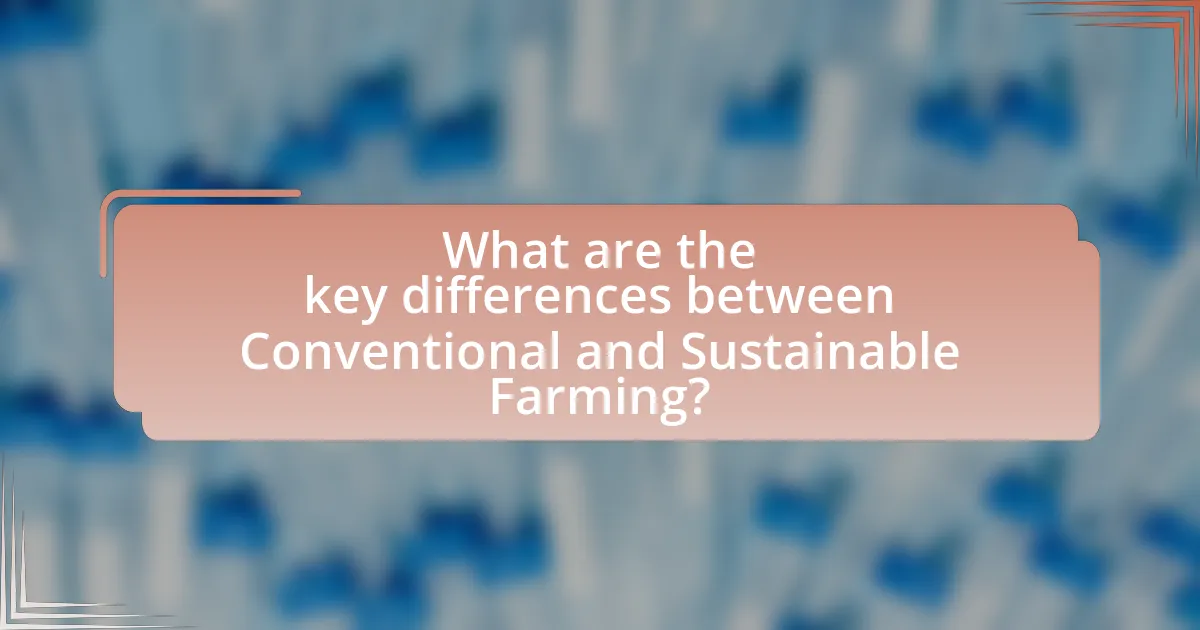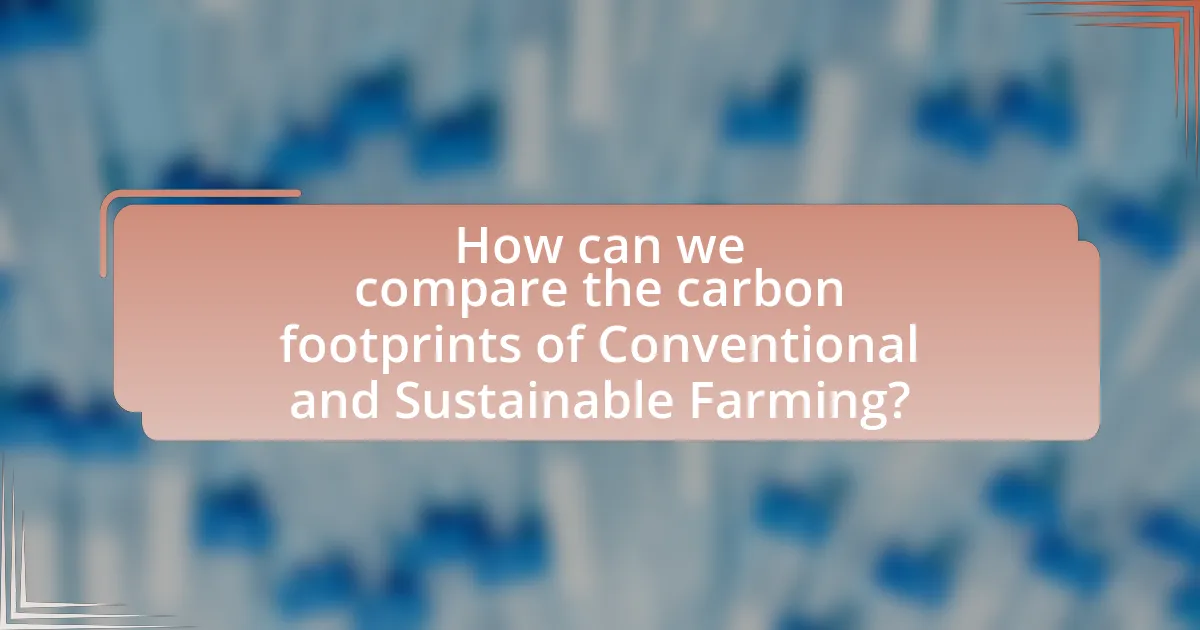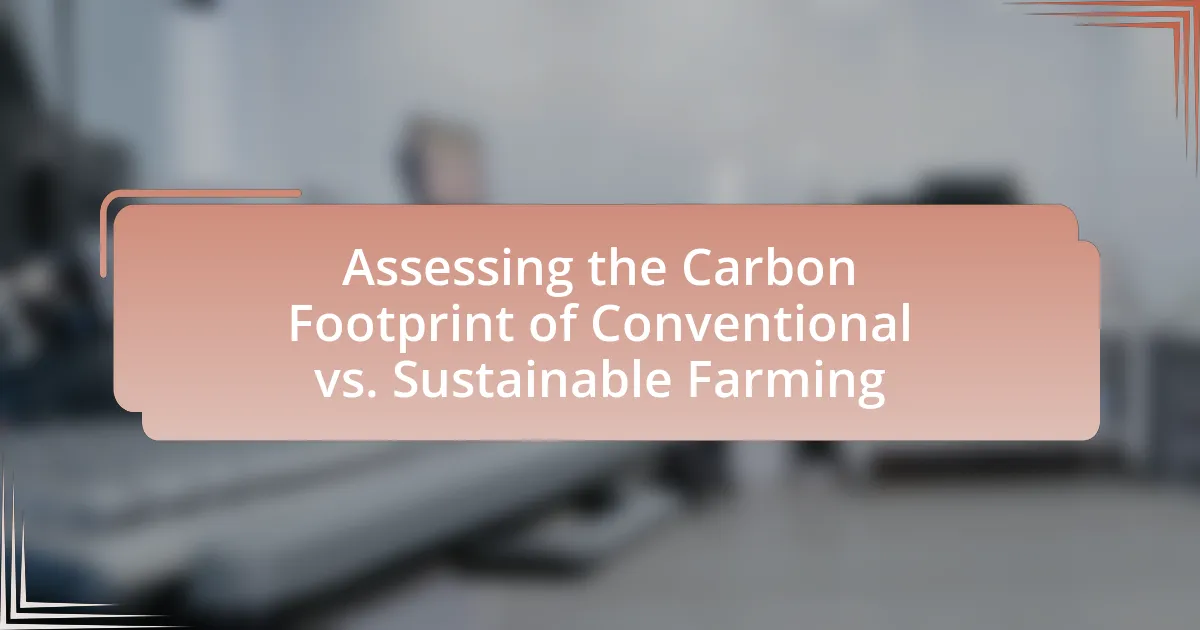The article focuses on assessing the carbon footprint of conventional versus sustainable farming practices, highlighting the greenhouse gas emissions associated with agricultural activities. It details how emissions are measured, the metrics used for quantification, and the environmental implications of these practices. The article contrasts conventional farming, which relies heavily on synthetic fertilizers and fossil fuels, with sustainable methods that promote soil health and biodiversity, ultimately leading to lower carbon emissions. Additionally, it discusses the importance of carbon footprint assessment for informing agricultural policies and consumer choices, as well as best practices for reducing emissions in farming.

What is the Carbon Footprint in Agriculture?
The carbon footprint in agriculture refers to the total greenhouse gas emissions, primarily carbon dioxide, methane, and nitrous oxide, produced directly and indirectly by agricultural activities. These emissions arise from various sources, including soil management, livestock production, fertilizer application, and energy use in farming operations. According to the Food and Agriculture Organization (FAO), agriculture contributes approximately 14% of global greenhouse gas emissions, highlighting its significant role in climate change.
How is the carbon footprint measured in farming practices?
The carbon footprint in farming practices is measured by calculating the total greenhouse gas emissions produced directly and indirectly by agricultural activities. This includes emissions from soil management, fertilizer application, livestock production, and energy use in farming operations. For instance, the Intergovernmental Panel on Climate Change (IPCC) provides guidelines for estimating emissions, which involve assessing factors such as land use changes, methane emissions from enteric fermentation in ruminants, and nitrous oxide emissions from fertilized soils. These calculations often utilize life cycle assessment (LCA) methodologies to provide a comprehensive view of the carbon footprint across the entire farming process, from production to consumption.
What metrics are used to quantify carbon emissions in agriculture?
Metrics used to quantify carbon emissions in agriculture include carbon dioxide equivalents (CO2e), which account for the global warming potential of various greenhouse gases, and life cycle assessment (LCA), which evaluates emissions across all stages of agricultural production. Additionally, the carbon footprint can be measured through direct emissions from soil management practices, fertilizer application, and livestock management. Studies indicate that agriculture contributes approximately 10-12% of total greenhouse gas emissions globally, highlighting the importance of these metrics in assessing environmental impact.
How do different farming practices impact carbon emissions?
Different farming practices significantly impact carbon emissions, with conventional farming typically resulting in higher emissions compared to sustainable practices. Conventional farming often relies on synthetic fertilizers and pesticides, which contribute to greenhouse gas emissions through production and application processes. For instance, the use of nitrogen fertilizers can lead to nitrous oxide emissions, a potent greenhouse gas. In contrast, sustainable farming practices, such as crop rotation, cover cropping, and organic farming, enhance soil health and carbon sequestration, thereby reducing overall emissions. Research indicates that sustainable practices can lower carbon emissions by up to 40% compared to conventional methods, as demonstrated in a study published in “Nature Sustainability” by authors Smith et al. (2020). This evidence underscores the critical role that farming practices play in influencing carbon emissions and climate change.
Why is assessing the carbon footprint important for farming?
Assessing the carbon footprint is important for farming because it helps identify the environmental impact of agricultural practices. By measuring greenhouse gas emissions associated with farming activities, farmers can implement strategies to reduce their carbon output, thereby contributing to climate change mitigation. For instance, a study published in the journal “Agricultural Systems” found that sustainable farming practices can reduce carbon emissions by up to 30% compared to conventional methods. This assessment not only aids in compliance with environmental regulations but also enhances the sustainability of food production systems.
What are the environmental implications of carbon emissions in agriculture?
Carbon emissions in agriculture significantly contribute to climate change, leading to adverse environmental effects such as increased global temperatures, altered precipitation patterns, and loss of biodiversity. Agriculture is responsible for approximately 10-12% of total greenhouse gas emissions, primarily through practices like soil cultivation, livestock production, and the use of synthetic fertilizers. These emissions not only exacerbate climate change but also result in soil degradation and water scarcity, further impacting ecosystems and agricultural productivity. For instance, the Intergovernmental Panel on Climate Change (IPCC) reports that reducing carbon emissions in agriculture can mitigate these environmental impacts and promote sustainable farming practices.
How does carbon footprint assessment influence agricultural policies?
Carbon footprint assessment significantly influences agricultural policies by providing data-driven insights that guide decision-making towards sustainability. Policymakers utilize carbon footprint metrics to evaluate the environmental impact of various farming practices, enabling them to promote sustainable agriculture through incentives and regulations. For instance, the European Union’s Common Agricultural Policy incorporates carbon footprint assessments to encourage practices that reduce greenhouse gas emissions, thereby aligning agricultural activities with climate goals. This evidence-based approach ensures that policies are effective in mitigating climate change while supporting agricultural productivity.

What are the key differences between Conventional and Sustainable Farming?
Conventional farming primarily relies on synthetic fertilizers, pesticides, and monoculture practices, while sustainable farming emphasizes organic methods, crop rotation, and biodiversity. Conventional farming often leads to soil degradation and increased greenhouse gas emissions due to chemical inputs and fossil fuel use, whereas sustainable farming practices aim to enhance soil health and reduce carbon footprints through natural inputs and environmentally friendly techniques. Research indicates that sustainable farming can sequester carbon in soil, potentially offsetting emissions, while conventional methods contribute significantly to climate change through high levels of carbon dioxide and nitrous oxide emissions from fertilizers.
How do Conventional Farming practices contribute to carbon emissions?
Conventional farming practices contribute to carbon emissions primarily through the use of synthetic fertilizers, fossil fuel-powered machinery, and land-use changes. The application of nitrogen-based fertilizers leads to nitrous oxide emissions, a greenhouse gas with a global warming potential 298 times greater than carbon dioxide. Additionally, the reliance on tractors and other machinery powered by fossil fuels results in significant carbon dioxide emissions. Furthermore, conventional farming often involves deforestation and soil degradation, which release stored carbon into the atmosphere. According to the Food and Agriculture Organization, agriculture accounts for approximately 14% of global greenhouse gas emissions, with conventional practices being a major contributor.
What specific practices in Conventional Farming lead to higher carbon footprints?
Specific practices in conventional farming that lead to higher carbon footprints include the extensive use of synthetic fertilizers, reliance on fossil fuel-powered machinery, and monoculture cropping systems. Synthetic fertilizers release nitrous oxide, a potent greenhouse gas, during application and decomposition, contributing significantly to carbon emissions. The use of fossil fuel-powered machinery for planting, harvesting, and transporting crops results in substantial carbon dioxide emissions. Additionally, monoculture cropping systems reduce biodiversity and soil health, leading to increased reliance on chemical inputs and further emissions. These practices collectively elevate the carbon footprint of conventional farming compared to more sustainable methods.
How does the use of fertilizers and pesticides affect carbon emissions in Conventional Farming?
The use of fertilizers and pesticides in conventional farming significantly increases carbon emissions. Fertilizers, particularly nitrogen-based ones, release nitrous oxide, a greenhouse gas that is 298 times more potent than carbon dioxide over a 100-year period. Additionally, the production and transportation of these fertilizers contribute to carbon emissions. Pesticides also contribute indirectly by requiring energy-intensive production processes and application methods, which further elevate the carbon footprint of conventional farming practices. Studies indicate that conventional farming can emit up to 30% more greenhouse gases compared to sustainable farming methods, highlighting the environmental impact of these agricultural inputs.
What practices define Sustainable Farming and its impact on carbon footprint?
Sustainable farming is defined by practices such as crop rotation, agroforestry, organic farming, and integrated pest management, which collectively aim to enhance soil health, conserve water, and reduce reliance on synthetic fertilizers and pesticides. These practices significantly lower the carbon footprint by promoting biodiversity and improving carbon sequestration in soil. For instance, a study published in the journal “Nature” found that organic farming can reduce greenhouse gas emissions by up to 30% compared to conventional methods due to decreased fertilizer use and enhanced soil carbon storage. Additionally, agroforestry systems can sequester up to 50% more carbon than monoculture systems, further mitigating climate change impacts.
How do crop rotation and organic practices reduce carbon emissions?
Crop rotation and organic practices reduce carbon emissions by enhancing soil health and promoting biodiversity, which leads to increased carbon sequestration. Crop rotation prevents soil depletion and reduces the need for synthetic fertilizers, which are significant sources of greenhouse gas emissions. For instance, a study published in “Agriculture, Ecosystems & Environment” by Drinkwater et al. (1998) found that diverse crop rotations can increase soil organic matter, thereby improving carbon storage in the soil. Additionally, organic practices, such as composting and reduced tillage, further enhance soil structure and microbial activity, which contribute to carbon retention. This combination of practices not only mitigates emissions but also fosters a more resilient agricultural ecosystem.
What role does soil health play in the carbon footprint of Sustainable Farming?
Soil health significantly reduces the carbon footprint of sustainable farming by enhancing carbon sequestration and improving nutrient cycling. Healthy soils, characterized by high organic matter content and biodiversity, can store more carbon dioxide from the atmosphere, effectively mitigating greenhouse gas emissions. Research indicates that practices such as cover cropping and reduced tillage, which promote soil health, can increase soil organic carbon levels by up to 1.1 billion tons annually in the United States alone. This demonstrates that maintaining soil health is crucial for sustainable farming practices aimed at lowering overall carbon emissions.

How can we compare the carbon footprints of Conventional and Sustainable Farming?
To compare the carbon footprints of Conventional and Sustainable Farming, one can analyze the greenhouse gas emissions associated with each method. Conventional farming typically results in higher carbon emissions due to reliance on synthetic fertilizers, fossil fuel-powered machinery, and monoculture practices, which can lead to soil degradation. In contrast, Sustainable Farming practices, such as crop rotation, organic fertilizers, and reduced tillage, generally produce lower emissions by enhancing soil health and promoting biodiversity. Research indicates that Sustainable Farming can reduce carbon emissions by up to 40% compared to Conventional methods, highlighting its potential for mitigating climate change impacts.
What methodologies are used to compare carbon footprints in agriculture?
Life Cycle Assessment (LCA) is the primary methodology used to compare carbon footprints in agriculture. LCA evaluates the environmental impacts of agricultural practices by analyzing the entire life cycle of products, from raw material extraction through production, distribution, use, and disposal. This method quantifies greenhouse gas emissions associated with each stage, allowing for a comprehensive comparison between conventional and sustainable farming practices. Studies, such as those published in the Journal of Cleaner Production, demonstrate that LCA can reveal significant differences in carbon emissions, highlighting the benefits of sustainable practices in reducing overall carbon footprints.
How do life cycle assessments contribute to understanding carbon footprints?
Life cycle assessments (LCAs) contribute to understanding carbon footprints by providing a comprehensive evaluation of the environmental impacts associated with all stages of a product’s life, from raw material extraction to disposal. LCAs quantify greenhouse gas emissions at each phase, allowing for a detailed analysis of how different farming practices, such as conventional versus sustainable methods, affect overall carbon output. For instance, a study published in the journal “Agricultural Systems” by Hill et al. (2019) demonstrated that sustainable farming practices can significantly reduce carbon emissions compared to conventional methods, highlighting the importance of LCAs in identifying and promoting lower-carbon alternatives in agriculture.
What case studies illustrate the differences in carbon footprints between the two farming types?
Case studies from various regions demonstrate significant differences in carbon footprints between conventional and sustainable farming. For instance, a study conducted by the University of California, Davis, found that sustainable farming practices, such as cover cropping and reduced tillage, can reduce greenhouse gas emissions by up to 30% compared to conventional methods. Another case study in the UK, published by the Soil Association, indicated that organic farming systems had a 40% lower carbon footprint than conventional farming due to reduced fertilizer use and enhanced soil carbon sequestration. These examples illustrate the tangible benefits of sustainable farming in mitigating climate change impacts.
What are the implications of these comparisons for farmers and consumers?
The implications of comparing the carbon footprints of conventional and sustainable farming for farmers and consumers include potential shifts in agricultural practices and consumer purchasing behavior. Farmers may adopt sustainable practices to reduce their carbon emissions, which can lead to increased operational costs initially but may result in long-term savings and market advantages as consumers increasingly prefer eco-friendly products. For consumers, awareness of the carbon footprint associated with their food choices can drive demand for sustainably produced goods, influencing market trends and potentially leading to higher prices for conventional products that are less environmentally friendly. This shift is supported by studies indicating that sustainable farming can reduce greenhouse gas emissions by up to 50% compared to conventional methods, thereby aligning agricultural practices with consumer values focused on environmental sustainability.
How can farmers transition from Conventional to Sustainable practices to reduce carbon footprints?
Farmers can transition from conventional to sustainable practices by adopting methods such as crop rotation, cover cropping, and integrated pest management, which collectively enhance soil health and reduce greenhouse gas emissions. Implementing crop rotation helps break pest cycles and improves soil fertility, while cover cropping prevents soil erosion and enhances carbon sequestration. Integrated pest management reduces reliance on chemical pesticides, further lowering carbon footprints. Research indicates that these practices can lead to a 20-30% reduction in carbon emissions compared to conventional farming methods, as demonstrated in studies by the Rodale Institute.
What choices can consumers make to support Sustainable Farming practices?
Consumers can support sustainable farming practices by choosing to purchase organic and locally sourced products. Organic farming methods reduce chemical inputs and promote biodiversity, while local sourcing minimizes transportation emissions, thereby lowering the carbon footprint associated with food distribution. According to the USDA, organic farming can lead to a 30% reduction in greenhouse gas emissions compared to conventional farming. Additionally, consumers can reduce meat consumption, as livestock farming is a significant contributor to carbon emissions; a study published in the journal “Nature” indicates that plant-based diets can reduce an individual’s carbon footprint by up to 50%. By making these informed choices, consumers directly contribute to the sustainability of agricultural practices.
What are the best practices for reducing carbon footprints in farming?
The best practices for reducing carbon footprints in farming include implementing crop rotation, utilizing cover crops, adopting no-till farming, optimizing fertilizer use, and integrating agroforestry. Crop rotation enhances soil health and reduces the need for chemical fertilizers, which can emit greenhouse gases. Cover crops prevent soil erosion and improve soil carbon sequestration. No-till farming minimizes soil disturbance, preserving soil structure and reducing carbon release. Optimizing fertilizer use through precision agriculture ensures that nutrients are applied efficiently, reducing excess emissions. Agroforestry combines agriculture and forestry, enhancing biodiversity and carbon storage. These practices collectively contribute to lower carbon emissions and promote sustainable farming.


